Comprehensive Analysis of Complex Project Management Principles
VerifiedAdded on 2023/06/11
|23
|6558
|476
Essay
AI Summary
This essay provides a comprehensive overview of complex project management, beginning with an introduction to the concept of projects and the increasing need for rigorous methodologies. It delves into a literature review, highlighting the perspectives of various researchers and experts on project complexity, distinguishing between descriptive and perceived complexity. The essay emphasizes the lack of consensus on the definition of complexity but explores key drivers and factors, classifying them into project size, variety, interrelations, and context-dependence. It further analyzes these factors in detail, discussing how they contribute to the overall complexity of projects, especially those with numerous interconnections, time constraints, and uncertainties. The ultimate aim is to enhance project managers' understanding and ability to manage complex projects effectively, utilizing tools and techniques to navigate the challenges posed by complexity.

Complex Project Management1
Complex Project Management
By Name
Course
Instructor
Institution
Location
Date
Complex Project Management
By Name
Course
Instructor
Institution
Location
Date
Paraphrase This Document
Need a fresh take? Get an instant paraphrase of this document with our AI Paraphraser
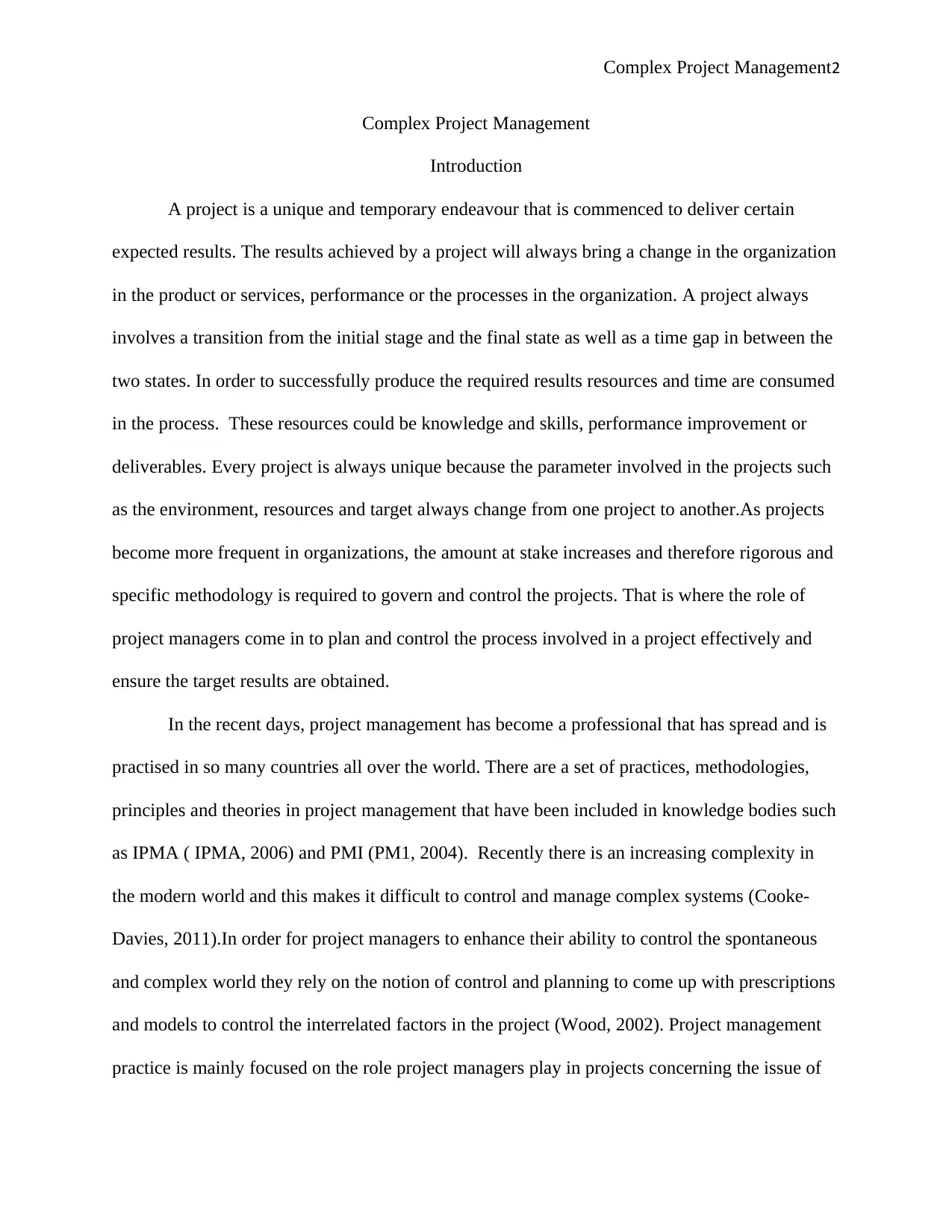
Complex Project Management2
Complex Project Management
Introduction
A project is a unique and temporary endeavour that is commenced to deliver certain
expected results. The results achieved by a project will always bring a change in the organization
in the product or services, performance or the processes in the organization. A project always
involves a transition from the initial stage and the final state as well as a time gap in between the
two states. In order to successfully produce the required results resources and time are consumed
in the process. These resources could be knowledge and skills, performance improvement or
deliverables. Every project is always unique because the parameter involved in the projects such
as the environment, resources and target always change from one project to another.As projects
become more frequent in organizations, the amount at stake increases and therefore rigorous and
specific methodology is required to govern and control the projects. That is where the role of
project managers come in to plan and control the process involved in a project effectively and
ensure the target results are obtained.
In the recent days, project management has become a professional that has spread and is
practised in so many countries all over the world. There are a set of practices, methodologies,
principles and theories in project management that have been included in knowledge bodies such
as IPMA ( IPMA, 2006) and PMI (PM1, 2004). Recently there is an increasing complexity in
the modern world and this makes it difficult to control and manage complex systems (Cooke-
Davies, 2011).In order for project managers to enhance their ability to control the spontaneous
and complex world they rely on the notion of control and planning to come up with prescriptions
and models to control the interrelated factors in the project (Wood, 2002). Project management
practice is mainly focused on the role project managers play in projects concerning the issue of
Complex Project Management
Introduction
A project is a unique and temporary endeavour that is commenced to deliver certain
expected results. The results achieved by a project will always bring a change in the organization
in the product or services, performance or the processes in the organization. A project always
involves a transition from the initial stage and the final state as well as a time gap in between the
two states. In order to successfully produce the required results resources and time are consumed
in the process. These resources could be knowledge and skills, performance improvement or
deliverables. Every project is always unique because the parameter involved in the projects such
as the environment, resources and target always change from one project to another.As projects
become more frequent in organizations, the amount at stake increases and therefore rigorous and
specific methodology is required to govern and control the projects. That is where the role of
project managers come in to plan and control the process involved in a project effectively and
ensure the target results are obtained.
In the recent days, project management has become a professional that has spread and is
practised in so many countries all over the world. There are a set of practices, methodologies,
principles and theories in project management that have been included in knowledge bodies such
as IPMA ( IPMA, 2006) and PMI (PM1, 2004). Recently there is an increasing complexity in
the modern world and this makes it difficult to control and manage complex systems (Cooke-
Davies, 2011).In order for project managers to enhance their ability to control the spontaneous
and complex world they rely on the notion of control and planning to come up with prescriptions
and models to control the interrelated factors in the project (Wood, 2002). Project management
practice is mainly focused on the role project managers play in projects concerning the issue of
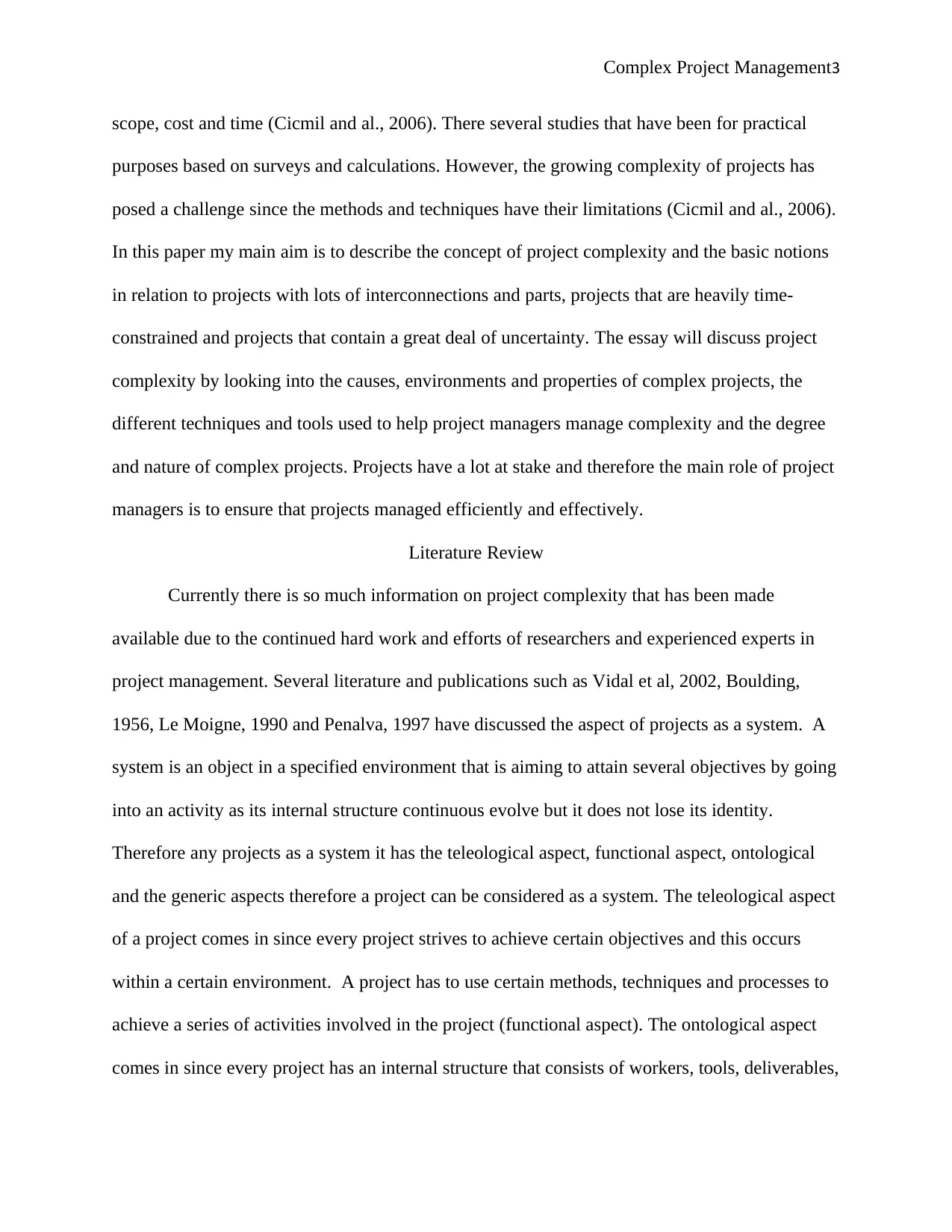
Complex Project Management3
scope, cost and time (Cicmil and al., 2006). There several studies that have been for practical
purposes based on surveys and calculations. However, the growing complexity of projects has
posed a challenge since the methods and techniques have their limitations (Cicmil and al., 2006).
In this paper my main aim is to describe the concept of project complexity and the basic notions
in relation to projects with lots of interconnections and parts, projects that are heavily time-
constrained and projects that contain a great deal of uncertainty. The essay will discuss project
complexity by looking into the causes, environments and properties of complex projects, the
different techniques and tools used to help project managers manage complexity and the degree
and nature of complex projects. Projects have a lot at stake and therefore the main role of project
managers is to ensure that projects managed efficiently and effectively.
Literature Review
Currently there is so much information on project complexity that has been made
available due to the continued hard work and efforts of researchers and experienced experts in
project management. Several literature and publications such as Vidal et al, 2002, Boulding,
1956, Le Moigne, 1990 and Penalva, 1997 have discussed the aspect of projects as a system. A
system is an object in a specified environment that is aiming to attain several objectives by going
into an activity as its internal structure continuous evolve but it does not lose its identity.
Therefore any projects as a system it has the teleological aspect, functional aspect, ontological
and the generic aspects therefore a project can be considered as a system. The teleological aspect
of a project comes in since every project strives to achieve certain objectives and this occurs
within a certain environment. A project has to use certain methods, techniques and processes to
achieve a series of activities involved in the project (functional aspect). The ontological aspect
comes in since every project has an internal structure that consists of workers, tools, deliverables,
scope, cost and time (Cicmil and al., 2006). There several studies that have been for practical
purposes based on surveys and calculations. However, the growing complexity of projects has
posed a challenge since the methods and techniques have their limitations (Cicmil and al., 2006).
In this paper my main aim is to describe the concept of project complexity and the basic notions
in relation to projects with lots of interconnections and parts, projects that are heavily time-
constrained and projects that contain a great deal of uncertainty. The essay will discuss project
complexity by looking into the causes, environments and properties of complex projects, the
different techniques and tools used to help project managers manage complexity and the degree
and nature of complex projects. Projects have a lot at stake and therefore the main role of project
managers is to ensure that projects managed efficiently and effectively.
Literature Review
Currently there is so much information on project complexity that has been made
available due to the continued hard work and efforts of researchers and experienced experts in
project management. Several literature and publications such as Vidal et al, 2002, Boulding,
1956, Le Moigne, 1990 and Penalva, 1997 have discussed the aspect of projects as a system. A
system is an object in a specified environment that is aiming to attain several objectives by going
into an activity as its internal structure continuous evolve but it does not lose its identity.
Therefore any projects as a system it has the teleological aspect, functional aspect, ontological
and the generic aspects therefore a project can be considered as a system. The teleological aspect
of a project comes in since every project strives to achieve certain objectives and this occurs
within a certain environment. A project has to use certain methods, techniques and processes to
achieve a series of activities involved in the project (functional aspect). The ontological aspect
comes in since every project has an internal structure that consists of workers, tools, deliverables,
⊘ This is a preview!⊘
Do you want full access?
Subscribe today to unlock all pages.

Trusted by 1+ million students worldwide
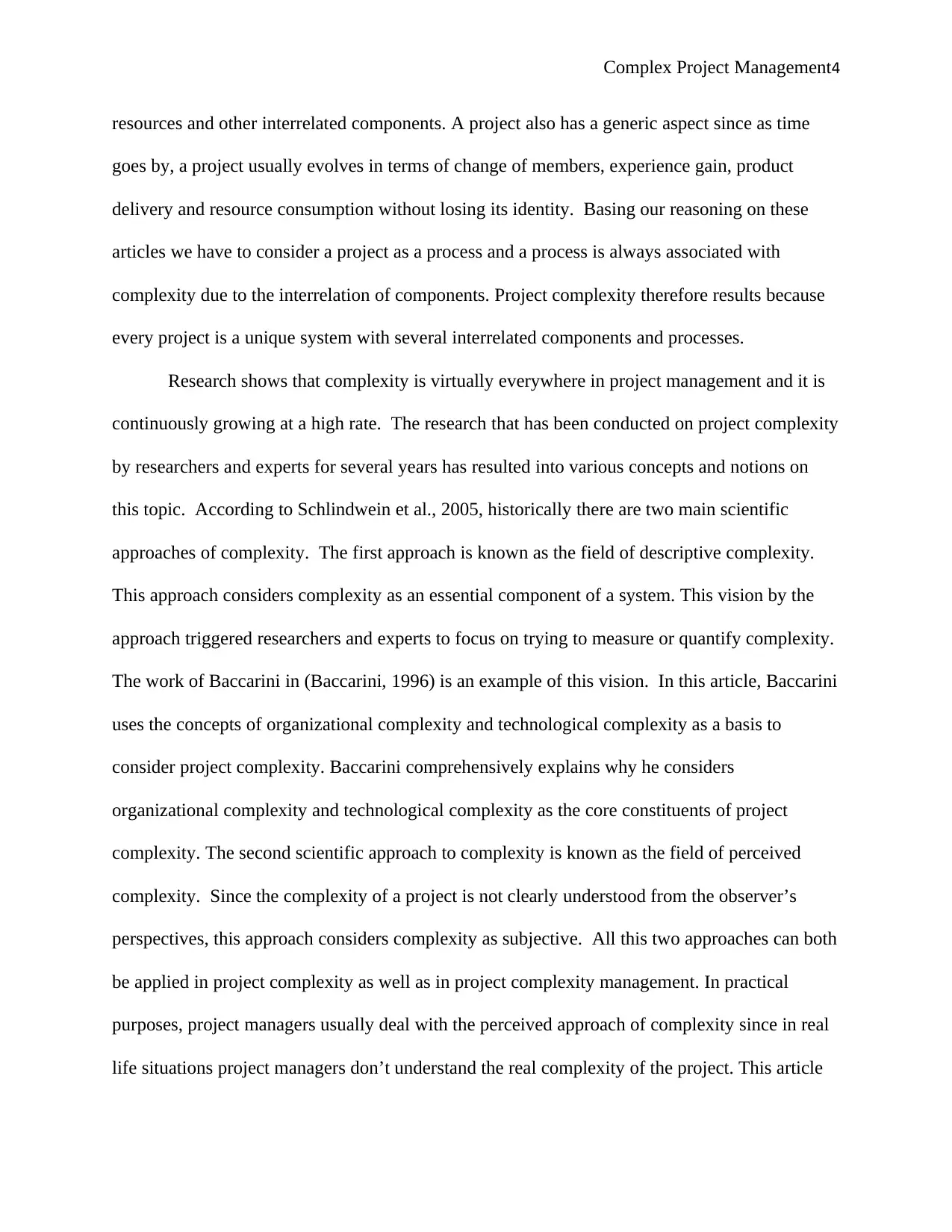
Complex Project Management4
resources and other interrelated components. A project also has a generic aspect since as time
goes by, a project usually evolves in terms of change of members, experience gain, product
delivery and resource consumption without losing its identity. Basing our reasoning on these
articles we have to consider a project as a process and a process is always associated with
complexity due to the interrelation of components. Project complexity therefore results because
every project is a unique system with several interrelated components and processes.
Research shows that complexity is virtually everywhere in project management and it is
continuously growing at a high rate. The research that has been conducted on project complexity
by researchers and experts for several years has resulted into various concepts and notions on
this topic. According to Schlindwein et al., 2005, historically there are two main scientific
approaches of complexity. The first approach is known as the field of descriptive complexity.
This approach considers complexity as an essential component of a system. This vision by the
approach triggered researchers and experts to focus on trying to measure or quantify complexity.
The work of Baccarini in (Baccarini, 1996) is an example of this vision. In this article, Baccarini
uses the concepts of organizational complexity and technological complexity as a basis to
consider project complexity. Baccarini comprehensively explains why he considers
organizational complexity and technological complexity as the core constituents of project
complexity. The second scientific approach to complexity is known as the field of perceived
complexity. Since the complexity of a project is not clearly understood from the observer’s
perspectives, this approach considers complexity as subjective. All this two approaches can both
be applied in project complexity as well as in project complexity management. In practical
purposes, project managers usually deal with the perceived approach of complexity since in real
life situations project managers don’t understand the real complexity of the project. This article
resources and other interrelated components. A project also has a generic aspect since as time
goes by, a project usually evolves in terms of change of members, experience gain, product
delivery and resource consumption without losing its identity. Basing our reasoning on these
articles we have to consider a project as a process and a process is always associated with
complexity due to the interrelation of components. Project complexity therefore results because
every project is a unique system with several interrelated components and processes.
Research shows that complexity is virtually everywhere in project management and it is
continuously growing at a high rate. The research that has been conducted on project complexity
by researchers and experts for several years has resulted into various concepts and notions on
this topic. According to Schlindwein et al., 2005, historically there are two main scientific
approaches of complexity. The first approach is known as the field of descriptive complexity.
This approach considers complexity as an essential component of a system. This vision by the
approach triggered researchers and experts to focus on trying to measure or quantify complexity.
The work of Baccarini in (Baccarini, 1996) is an example of this vision. In this article, Baccarini
uses the concepts of organizational complexity and technological complexity as a basis to
consider project complexity. Baccarini comprehensively explains why he considers
organizational complexity and technological complexity as the core constituents of project
complexity. The second scientific approach to complexity is known as the field of perceived
complexity. Since the complexity of a project is not clearly understood from the observer’s
perspectives, this approach considers complexity as subjective. All this two approaches can both
be applied in project complexity as well as in project complexity management. In practical
purposes, project managers usually deal with the perceived approach of complexity since in real
life situations project managers don’t understand the real complexity of the project. This article
Paraphrase This Document
Need a fresh take? Get an instant paraphrase of this document with our AI Paraphraser
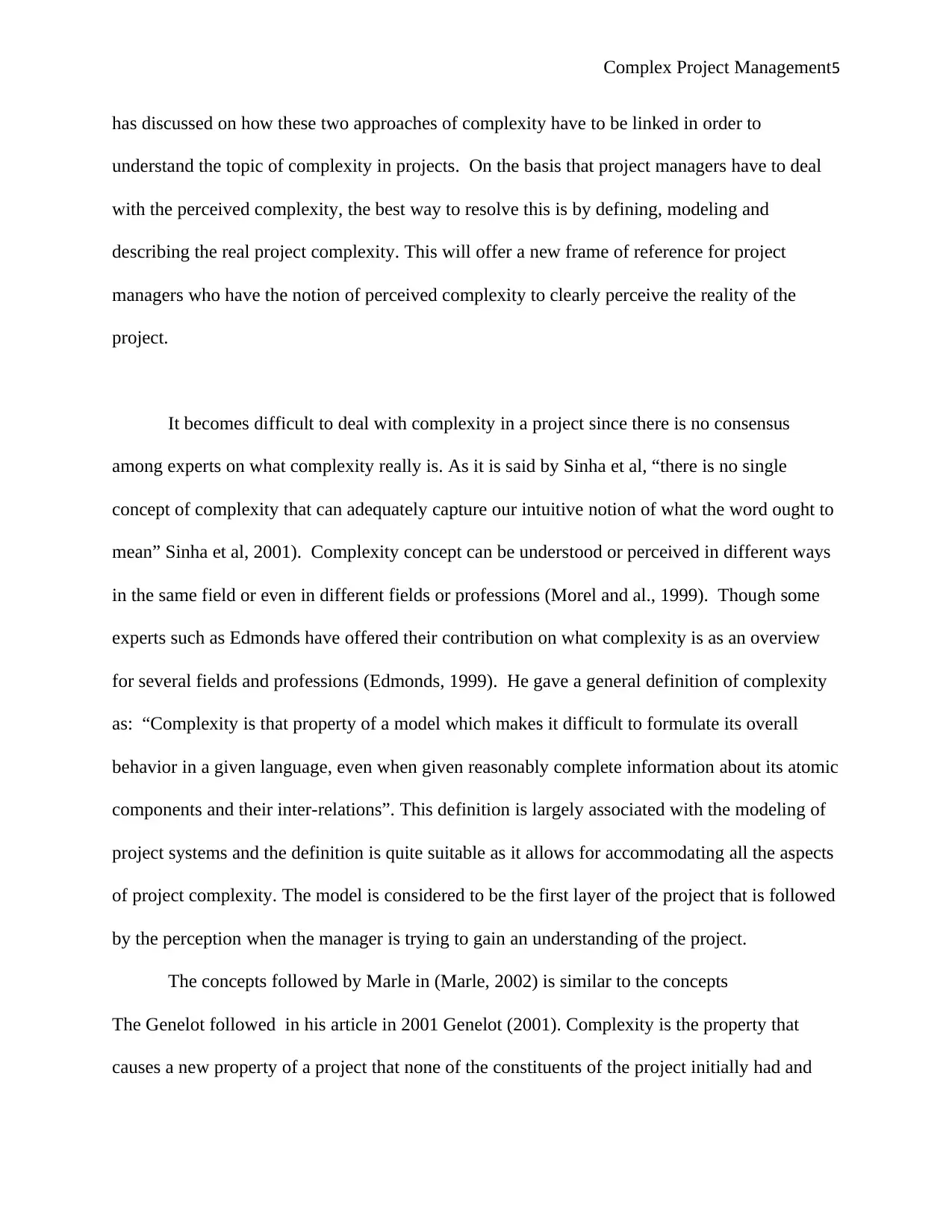
Complex Project Management5
has discussed on how these two approaches of complexity have to be linked in order to
understand the topic of complexity in projects. On the basis that project managers have to deal
with the perceived complexity, the best way to resolve this is by defining, modeling and
describing the real project complexity. This will offer a new frame of reference for project
managers who have the notion of perceived complexity to clearly perceive the reality of the
project.
It becomes difficult to deal with complexity in a project since there is no consensus
among experts on what complexity really is. As it is said by Sinha et al, “there is no single
concept of complexity that can adequately capture our intuitive notion of what the word ought to
mean” Sinha et al, 2001). Complexity concept can be understood or perceived in different ways
in the same field or even in different fields or professions (Morel and al., 1999). Though some
experts such as Edmonds have offered their contribution on what complexity is as an overview
for several fields and professions (Edmonds, 1999). He gave a general definition of complexity
as: “Complexity is that property of a model which makes it difficult to formulate its overall
behavior in a given language, even when given reasonably complete information about its atomic
components and their inter-relations”. This definition is largely associated with the modeling of
project systems and the definition is quite suitable as it allows for accommodating all the aspects
of project complexity. The model is considered to be the first layer of the project that is followed
by the perception when the manager is trying to gain an understanding of the project.
The concepts followed by Marle in (Marle, 2002) is similar to the concepts
The Genelot followed in his article in 2001 Genelot (2001). Complexity is the property that
causes a new property of a project that none of the constituents of the project initially had and
has discussed on how these two approaches of complexity have to be linked in order to
understand the topic of complexity in projects. On the basis that project managers have to deal
with the perceived complexity, the best way to resolve this is by defining, modeling and
describing the real project complexity. This will offer a new frame of reference for project
managers who have the notion of perceived complexity to clearly perceive the reality of the
project.
It becomes difficult to deal with complexity in a project since there is no consensus
among experts on what complexity really is. As it is said by Sinha et al, “there is no single
concept of complexity that can adequately capture our intuitive notion of what the word ought to
mean” Sinha et al, 2001). Complexity concept can be understood or perceived in different ways
in the same field or even in different fields or professions (Morel and al., 1999). Though some
experts such as Edmonds have offered their contribution on what complexity is as an overview
for several fields and professions (Edmonds, 1999). He gave a general definition of complexity
as: “Complexity is that property of a model which makes it difficult to formulate its overall
behavior in a given language, even when given reasonably complete information about its atomic
components and their inter-relations”. This definition is largely associated with the modeling of
project systems and the definition is quite suitable as it allows for accommodating all the aspects
of project complexity. The model is considered to be the first layer of the project that is followed
by the perception when the manager is trying to gain an understanding of the project.
The concepts followed by Marle in (Marle, 2002) is similar to the concepts
The Genelot followed in his article in 2001 Genelot (2001). Complexity is the property that
causes a new property of a project that none of the constituents of the project initially had and
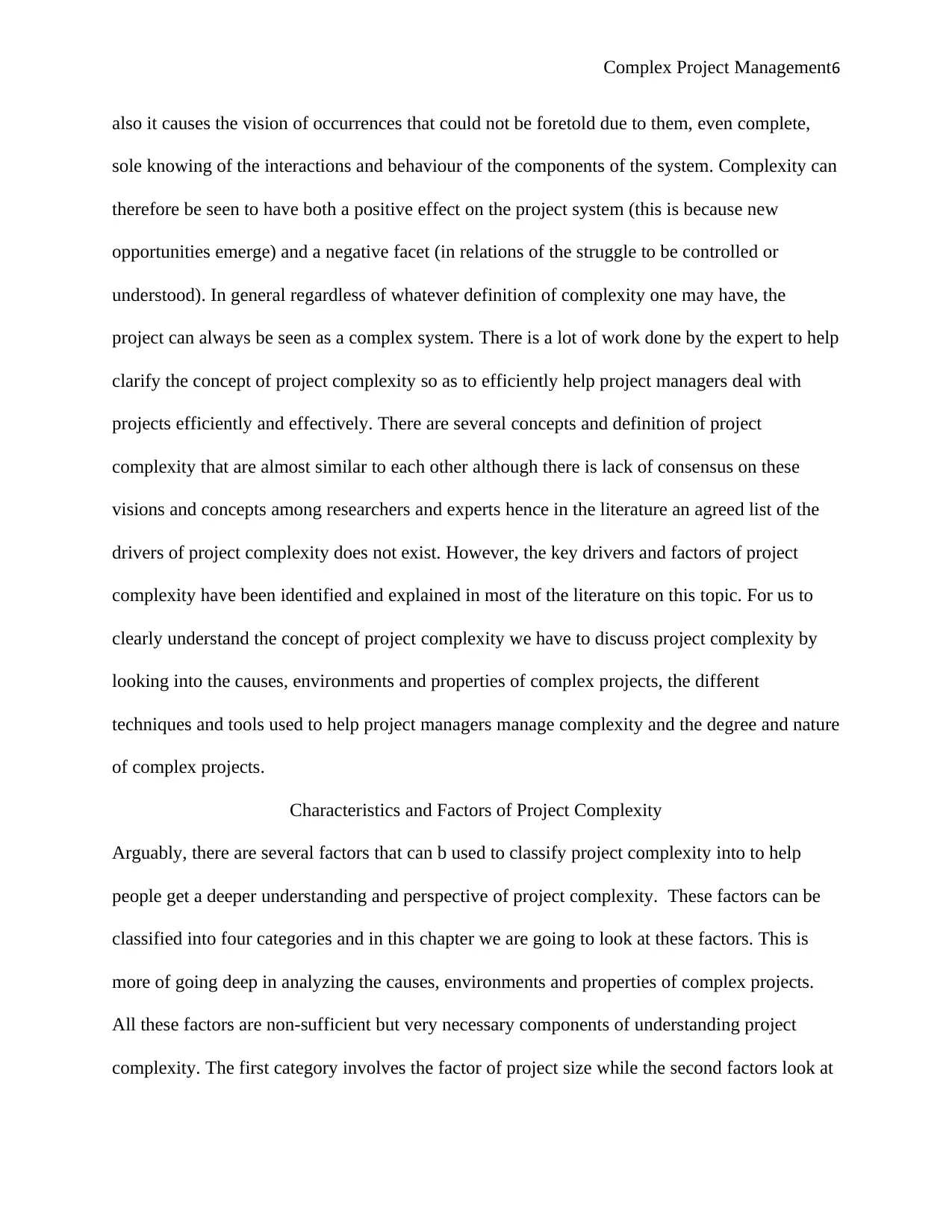
Complex Project Management6
also it causes the vision of occurrences that could not be foretold due to them, even complete,
sole knowing of the interactions and behaviour of the components of the system. Complexity can
therefore be seen to have both a positive effect on the project system (this is because new
opportunities emerge) and a negative facet (in relations of the struggle to be controlled or
understood). In general regardless of whatever definition of complexity one may have, the
project can always be seen as a complex system. There is a lot of work done by the expert to help
clarify the concept of project complexity so as to efficiently help project managers deal with
projects efficiently and effectively. There are several concepts and definition of project
complexity that are almost similar to each other although there is lack of consensus on these
visions and concepts among researchers and experts hence in the literature an agreed list of the
drivers of project complexity does not exist. However, the key drivers and factors of project
complexity have been identified and explained in most of the literature on this topic. For us to
clearly understand the concept of project complexity we have to discuss project complexity by
looking into the causes, environments and properties of complex projects, the different
techniques and tools used to help project managers manage complexity and the degree and nature
of complex projects.
Characteristics and Factors of Project Complexity
Arguably, there are several factors that can b used to classify project complexity into to help
people get a deeper understanding and perspective of project complexity. These factors can be
classified into four categories and in this chapter we are going to look at these factors. This is
more of going deep in analyzing the causes, environments and properties of complex projects.
All these factors are non-sufficient but very necessary components of understanding project
complexity. The first category involves the factor of project size while the second factors look at
also it causes the vision of occurrences that could not be foretold due to them, even complete,
sole knowing of the interactions and behaviour of the components of the system. Complexity can
therefore be seen to have both a positive effect on the project system (this is because new
opportunities emerge) and a negative facet (in relations of the struggle to be controlled or
understood). In general regardless of whatever definition of complexity one may have, the
project can always be seen as a complex system. There is a lot of work done by the expert to help
clarify the concept of project complexity so as to efficiently help project managers deal with
projects efficiently and effectively. There are several concepts and definition of project
complexity that are almost similar to each other although there is lack of consensus on these
visions and concepts among researchers and experts hence in the literature an agreed list of the
drivers of project complexity does not exist. However, the key drivers and factors of project
complexity have been identified and explained in most of the literature on this topic. For us to
clearly understand the concept of project complexity we have to discuss project complexity by
looking into the causes, environments and properties of complex projects, the different
techniques and tools used to help project managers manage complexity and the degree and nature
of complex projects.
Characteristics and Factors of Project Complexity
Arguably, there are several factors that can b used to classify project complexity into to help
people get a deeper understanding and perspective of project complexity. These factors can be
classified into four categories and in this chapter we are going to look at these factors. This is
more of going deep in analyzing the causes, environments and properties of complex projects.
All these factors are non-sufficient but very necessary components of understanding project
complexity. The first category involves the factor of project size while the second factors look at
⊘ This is a preview!⊘
Do you want full access?
Subscribe today to unlock all pages.

Trusted by 1+ million students worldwide
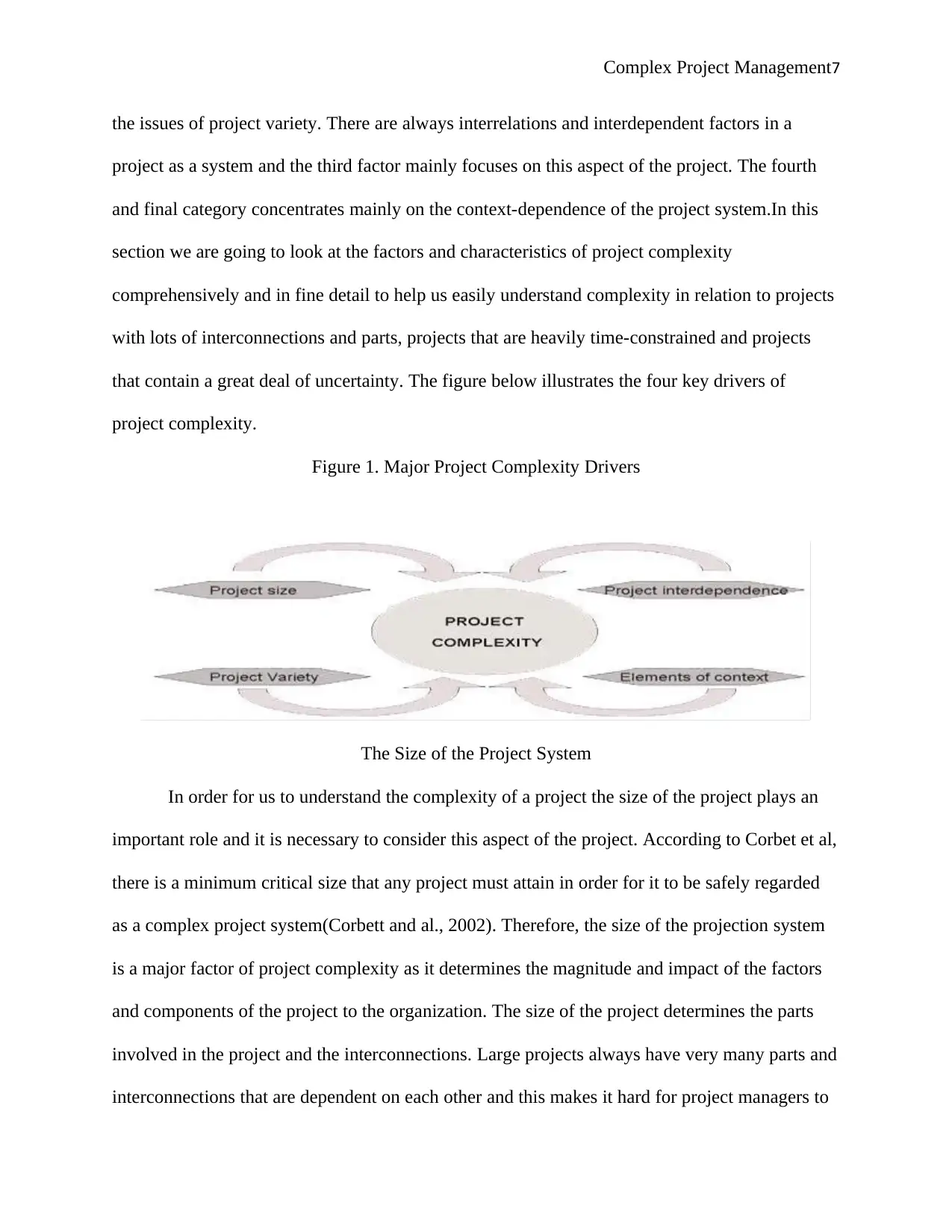
Complex Project Management7
the issues of project variety. There are always interrelations and interdependent factors in a
project as a system and the third factor mainly focuses on this aspect of the project. The fourth
and final category concentrates mainly on the context-dependence of the project system.In this
section we are going to look at the factors and characteristics of project complexity
comprehensively and in fine detail to help us easily understand complexity in relation to projects
with lots of interconnections and parts, projects that are heavily time-constrained and projects
that contain a great deal of uncertainty. The figure below illustrates the four key drivers of
project complexity.
Figure 1. Major Project Complexity Drivers
The Size of the Project System
In order for us to understand the complexity of a project the size of the project plays an
important role and it is necessary to consider this aspect of the project. According to Corbet et al,
there is a minimum critical size that any project must attain in order for it to be safely regarded
as a complex project system(Corbett and al., 2002). Therefore, the size of the projection system
is a major factor of project complexity as it determines the magnitude and impact of the factors
and components of the project to the organization. The size of the project determines the parts
involved in the project and the interconnections. Large projects always have very many parts and
interconnections that are dependent on each other and this makes it hard for project managers to
the issues of project variety. There are always interrelations and interdependent factors in a
project as a system and the third factor mainly focuses on this aspect of the project. The fourth
and final category concentrates mainly on the context-dependence of the project system.In this
section we are going to look at the factors and characteristics of project complexity
comprehensively and in fine detail to help us easily understand complexity in relation to projects
with lots of interconnections and parts, projects that are heavily time-constrained and projects
that contain a great deal of uncertainty. The figure below illustrates the four key drivers of
project complexity.
Figure 1. Major Project Complexity Drivers
The Size of the Project System
In order for us to understand the complexity of a project the size of the project plays an
important role and it is necessary to consider this aspect of the project. According to Corbet et al,
there is a minimum critical size that any project must attain in order for it to be safely regarded
as a complex project system(Corbett and al., 2002). Therefore, the size of the projection system
is a major factor of project complexity as it determines the magnitude and impact of the factors
and components of the project to the organization. The size of the project determines the parts
involved in the project and the interconnections. Large projects always have very many parts and
interconnections that are dependent on each other and this makes it hard for project managers to
Paraphrase This Document
Need a fresh take? Get an instant paraphrase of this document with our AI Paraphraser
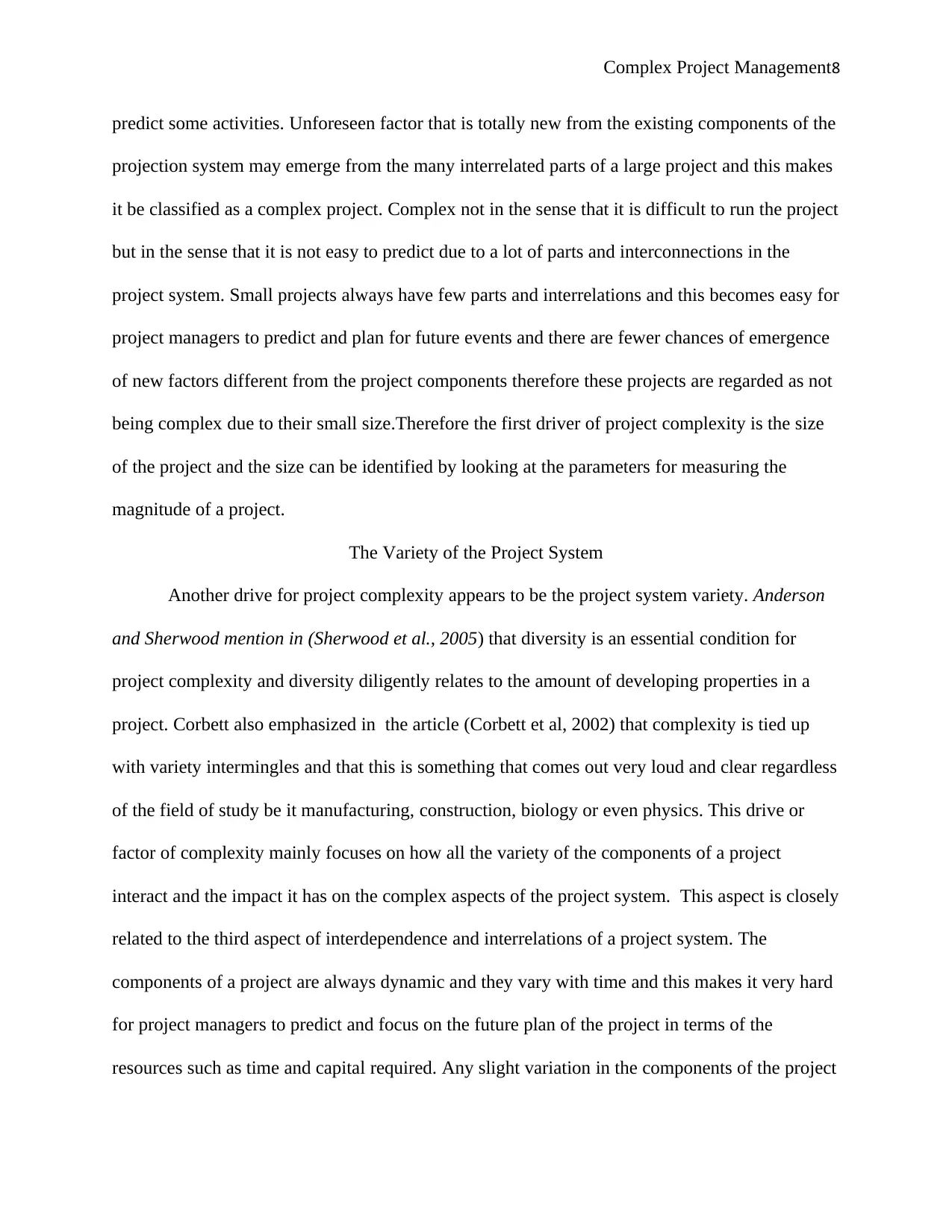
Complex Project Management8
predict some activities. Unforeseen factor that is totally new from the existing components of the
projection system may emerge from the many interrelated parts of a large project and this makes
it be classified as a complex project. Complex not in the sense that it is difficult to run the project
but in the sense that it is not easy to predict due to a lot of parts and interconnections in the
project system. Small projects always have few parts and interrelations and this becomes easy for
project managers to predict and plan for future events and there are fewer chances of emergence
of new factors different from the project components therefore these projects are regarded as not
being complex due to their small size.Therefore the first driver of project complexity is the size
of the project and the size can be identified by looking at the parameters for measuring the
magnitude of a project.
The Variety of the Project System
Another drive for project complexity appears to be the project system variety. Anderson
and Sherwood mention in (Sherwood et al., 2005) that diversity is an essential condition for
project complexity and diversity diligently relates to the amount of developing properties in a
project. Corbett also emphasized in the article (Corbett et al, 2002) that complexity is tied up
with variety intermingles and that this is something that comes out very loud and clear regardless
of the field of study be it manufacturing, construction, biology or even physics. This drive or
factor of complexity mainly focuses on how all the variety of the components of a project
interact and the impact it has on the complex aspects of the project system. This aspect is closely
related to the third aspect of interdependence and interrelations of a project system. The
components of a project are always dynamic and they vary with time and this makes it very hard
for project managers to predict and focus on the future plan of the project in terms of the
resources such as time and capital required. Any slight variation in the components of the project
predict some activities. Unforeseen factor that is totally new from the existing components of the
projection system may emerge from the many interrelated parts of a large project and this makes
it be classified as a complex project. Complex not in the sense that it is difficult to run the project
but in the sense that it is not easy to predict due to a lot of parts and interconnections in the
project system. Small projects always have few parts and interrelations and this becomes easy for
project managers to predict and plan for future events and there are fewer chances of emergence
of new factors different from the project components therefore these projects are regarded as not
being complex due to their small size.Therefore the first driver of project complexity is the size
of the project and the size can be identified by looking at the parameters for measuring the
magnitude of a project.
The Variety of the Project System
Another drive for project complexity appears to be the project system variety. Anderson
and Sherwood mention in (Sherwood et al., 2005) that diversity is an essential condition for
project complexity and diversity diligently relates to the amount of developing properties in a
project. Corbett also emphasized in the article (Corbett et al, 2002) that complexity is tied up
with variety intermingles and that this is something that comes out very loud and clear regardless
of the field of study be it manufacturing, construction, biology or even physics. This drive or
factor of complexity mainly focuses on how all the variety of the components of a project
interact and the impact it has on the complex aspects of the project system. This aspect is closely
related to the third aspect of interdependence and interrelations of a project system. The
components of a project are always dynamic and they vary with time and this makes it very hard
for project managers to predict and focus on the future plan of the project in terms of the
resources such as time and capital required. Any slight variation in the components of the project
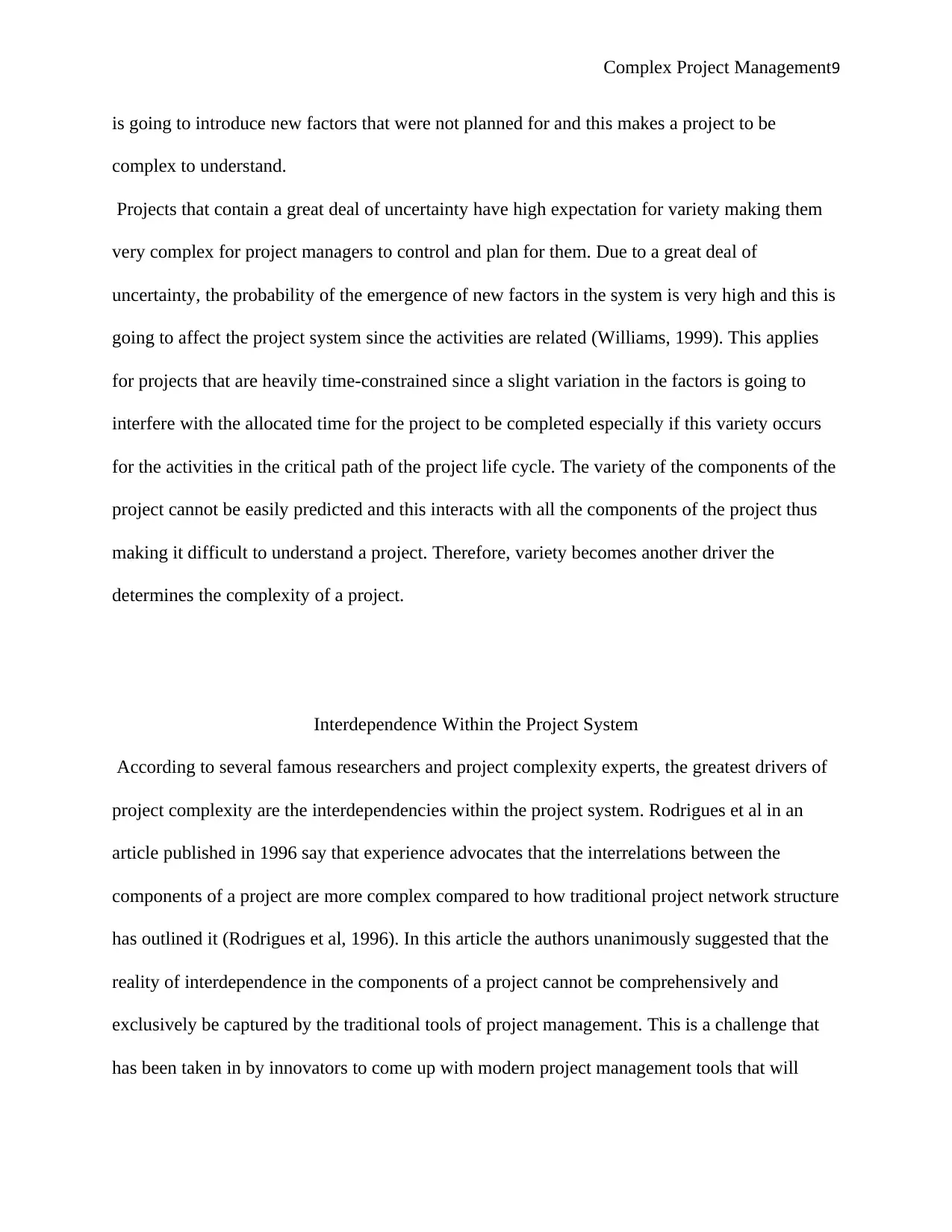
Complex Project Management9
is going to introduce new factors that were not planned for and this makes a project to be
complex to understand.
Projects that contain a great deal of uncertainty have high expectation for variety making them
very complex for project managers to control and plan for them. Due to a great deal of
uncertainty, the probability of the emergence of new factors in the system is very high and this is
going to affect the project system since the activities are related (Williams, 1999). This applies
for projects that are heavily time-constrained since a slight variation in the factors is going to
interfere with the allocated time for the project to be completed especially if this variety occurs
for the activities in the critical path of the project life cycle. The variety of the components of the
project cannot be easily predicted and this interacts with all the components of the project thus
making it difficult to understand a project. Therefore, variety becomes another driver the
determines the complexity of a project.
Interdependence Within the Project System
According to several famous researchers and project complexity experts, the greatest drivers of
project complexity are the interdependencies within the project system. Rodrigues et al in an
article published in 1996 say that experience advocates that the interrelations between the
components of a project are more complex compared to how traditional project network structure
has outlined it (Rodrigues et al, 1996). In this article the authors unanimously suggested that the
reality of interdependence in the components of a project cannot be comprehensively and
exclusively be captured by the traditional tools of project management. This is a challenge that
has been taken in by innovators to come up with modern project management tools that will
is going to introduce new factors that were not planned for and this makes a project to be
complex to understand.
Projects that contain a great deal of uncertainty have high expectation for variety making them
very complex for project managers to control and plan for them. Due to a great deal of
uncertainty, the probability of the emergence of new factors in the system is very high and this is
going to affect the project system since the activities are related (Williams, 1999). This applies
for projects that are heavily time-constrained since a slight variation in the factors is going to
interfere with the allocated time for the project to be completed especially if this variety occurs
for the activities in the critical path of the project life cycle. The variety of the components of the
project cannot be easily predicted and this interacts with all the components of the project thus
making it difficult to understand a project. Therefore, variety becomes another driver the
determines the complexity of a project.
Interdependence Within the Project System
According to several famous researchers and project complexity experts, the greatest drivers of
project complexity are the interdependencies within the project system. Rodrigues et al in an
article published in 1996 say that experience advocates that the interrelations between the
components of a project are more complex compared to how traditional project network structure
has outlined it (Rodrigues et al, 1996). In this article the authors unanimously suggested that the
reality of interdependence in the components of a project cannot be comprehensively and
exclusively be captured by the traditional tools of project management. This is a challenge that
has been taken in by innovators to come up with modern project management tools that will
⊘ This is a preview!⊘
Do you want full access?
Subscribe today to unlock all pages.

Trusted by 1+ million students worldwide
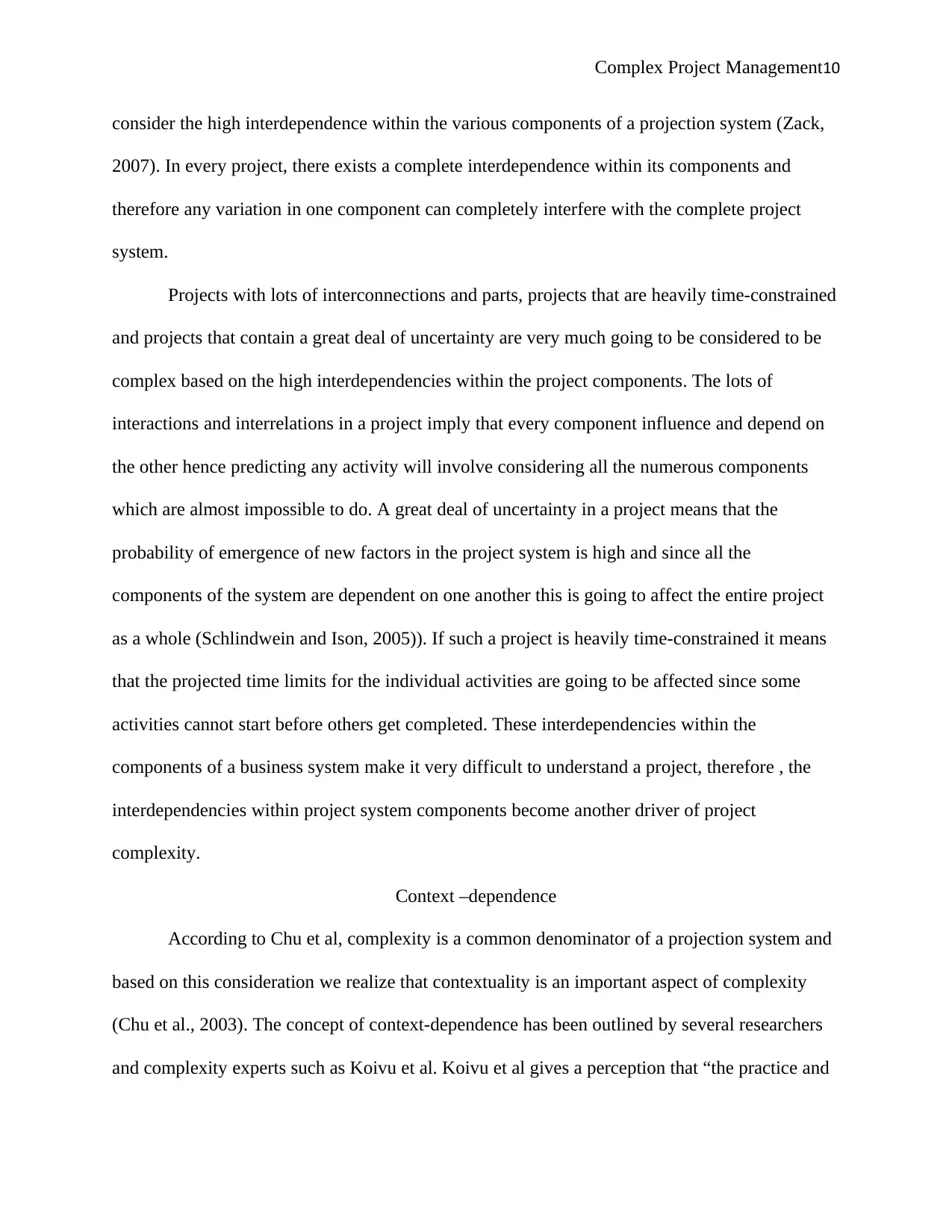
Complex Project Management10
consider the high interdependence within the various components of a projection system (Zack,
2007). In every project, there exists a complete interdependence within its components and
therefore any variation in one component can completely interfere with the complete project
system.
Projects with lots of interconnections and parts, projects that are heavily time-constrained
and projects that contain a great deal of uncertainty are very much going to be considered to be
complex based on the high interdependencies within the project components. The lots of
interactions and interrelations in a project imply that every component influence and depend on
the other hence predicting any activity will involve considering all the numerous components
which are almost impossible to do. A great deal of uncertainty in a project means that the
probability of emergence of new factors in the project system is high and since all the
components of the system are dependent on one another this is going to affect the entire project
as a whole (Schlindwein and Ison, 2005)). If such a project is heavily time-constrained it means
that the projected time limits for the individual activities are going to be affected since some
activities cannot start before others get completed. These interdependencies within the
components of a business system make it very difficult to understand a project, therefore , the
interdependencies within project system components become another driver of project
complexity.
Context –dependence
According to Chu et al, complexity is a common denominator of a projection system and
based on this consideration we realize that contextuality is an important aspect of complexity
(Chu et al., 2003). The concept of context-dependence has been outlined by several researchers
and complexity experts such as Koivu et al. Koivu et al gives a perception that “the practice and
consider the high interdependence within the various components of a projection system (Zack,
2007). In every project, there exists a complete interdependence within its components and
therefore any variation in one component can completely interfere with the complete project
system.
Projects with lots of interconnections and parts, projects that are heavily time-constrained
and projects that contain a great deal of uncertainty are very much going to be considered to be
complex based on the high interdependencies within the project components. The lots of
interactions and interrelations in a project imply that every component influence and depend on
the other hence predicting any activity will involve considering all the numerous components
which are almost impossible to do. A great deal of uncertainty in a project means that the
probability of emergence of new factors in the project system is high and since all the
components of the system are dependent on one another this is going to affect the entire project
as a whole (Schlindwein and Ison, 2005)). If such a project is heavily time-constrained it means
that the projected time limits for the individual activities are going to be affected since some
activities cannot start before others get completed. These interdependencies within the
components of a business system make it very difficult to understand a project, therefore , the
interdependencies within project system components become another driver of project
complexity.
Context –dependence
According to Chu et al, complexity is a common denominator of a projection system and
based on this consideration we realize that contextuality is an important aspect of complexity
(Chu et al., 2003). The concept of context-dependence has been outlined by several researchers
and complexity experts such as Koivu et al. Koivu et al gives a perception that “the practice and
Paraphrase This Document
Need a fresh take? Get an instant paraphrase of this document with our AI Paraphraser
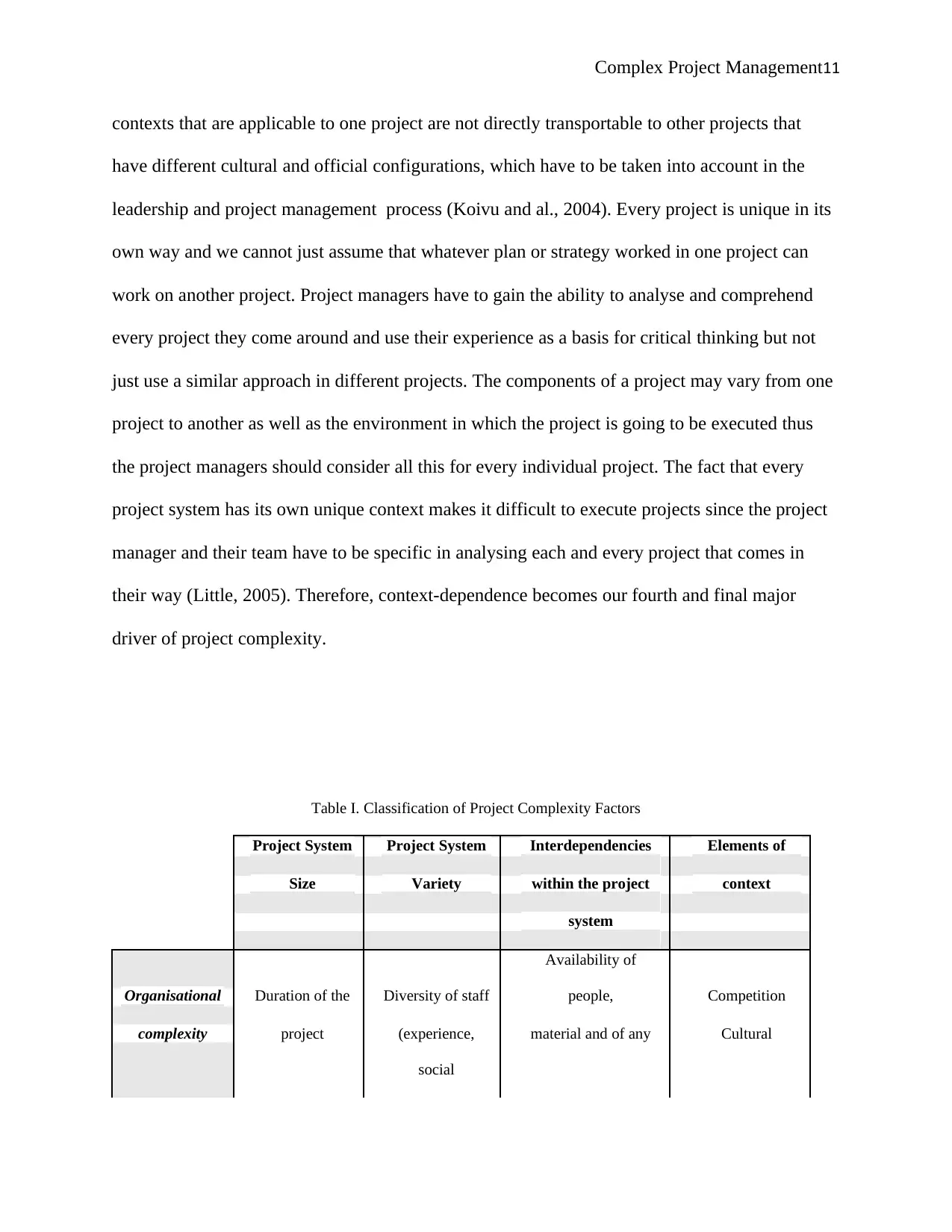
Complex Project Management11
contexts that are applicable to one project are not directly transportable to other projects that
have different cultural and official configurations, which have to be taken into account in the
leadership and project management process (Koivu and al., 2004). Every project is unique in its
own way and we cannot just assume that whatever plan or strategy worked in one project can
work on another project. Project managers have to gain the ability to analyse and comprehend
every project they come around and use their experience as a basis for critical thinking but not
just use a similar approach in different projects. The components of a project may vary from one
project to another as well as the environment in which the project is going to be executed thus
the project managers should consider all this for every individual project. The fact that every
project system has its own unique context makes it difficult to execute projects since the project
manager and their team have to be specific in analysing each and every project that comes in
their way (Little, 2005). Therefore, context-dependence becomes our fourth and final major
driver of project complexity.
Table I. Classification of Project Complexity Factors
Project System Project System Interdependencies Elements of
Size Variety within the project context
system
Organisational Duration of the Diversity of staff
Availability of
people, Competition
complexity project (experience,
social
material and of any Cultural
contexts that are applicable to one project are not directly transportable to other projects that
have different cultural and official configurations, which have to be taken into account in the
leadership and project management process (Koivu and al., 2004). Every project is unique in its
own way and we cannot just assume that whatever plan or strategy worked in one project can
work on another project. Project managers have to gain the ability to analyse and comprehend
every project they come around and use their experience as a basis for critical thinking but not
just use a similar approach in different projects. The components of a project may vary from one
project to another as well as the environment in which the project is going to be executed thus
the project managers should consider all this for every individual project. The fact that every
project system has its own unique context makes it difficult to execute projects since the project
manager and their team have to be specific in analysing each and every project that comes in
their way (Little, 2005). Therefore, context-dependence becomes our fourth and final major
driver of project complexity.
Table I. Classification of Project Complexity Factors
Project System Project System Interdependencies Elements of
Size Variety within the project context
system
Organisational Duration of the Diversity of staff
Availability of
people, Competition
complexity project (experience,
social
material and of any Cultural
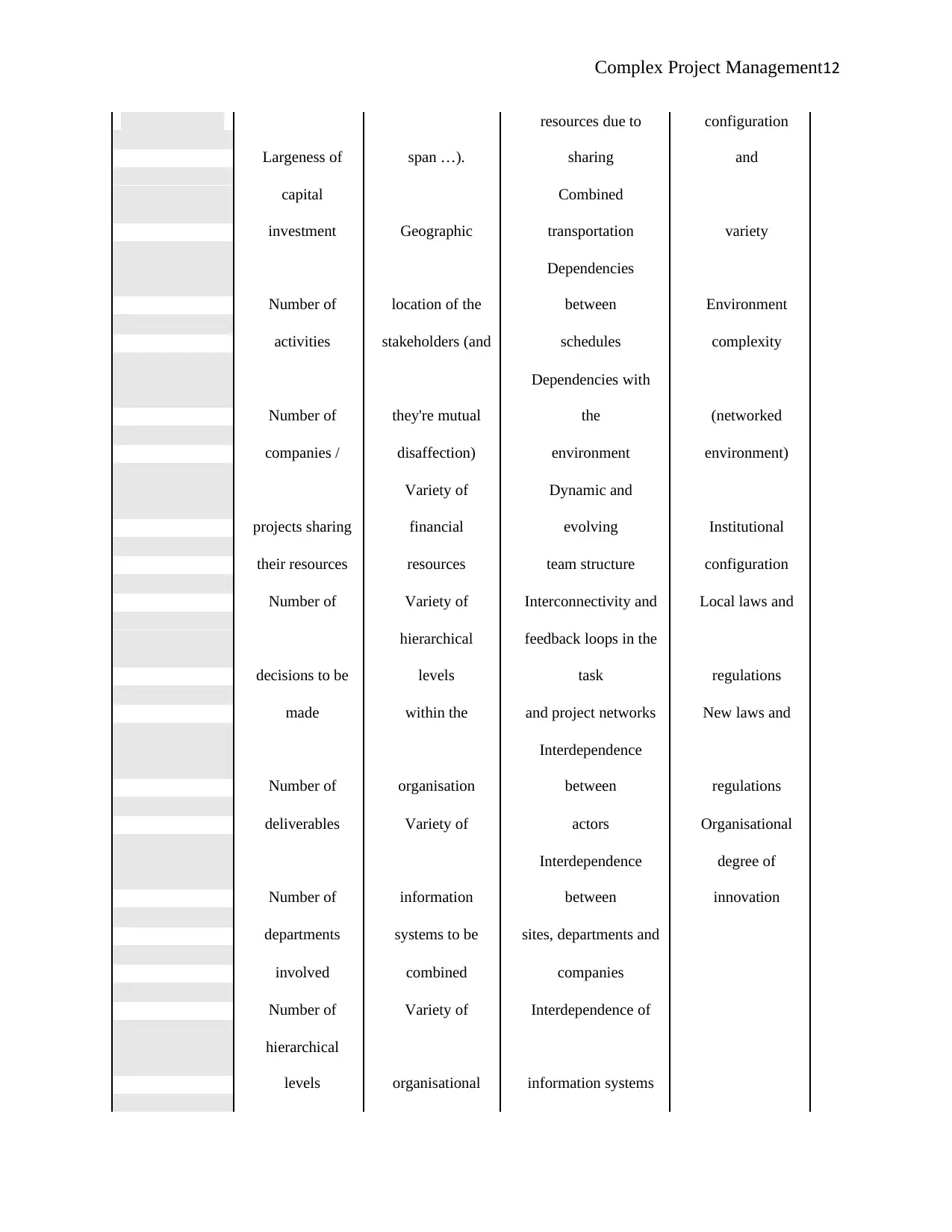
Complex Project Management12
Largeness of span …).
resources due to
sharing
configuration
and
capital
investment Geographic
Combined
transportation variety
Number of location of the
Dependencies
between Environment
activities stakeholders (and schedules complexity
Number of they're mutual
Dependencies with
the (networked
companies /
disaffection) environment
environment)
projects sharing
Variety of
financial
Dynamic and
evolving Institutional
their resources
resources team structure
configuration
Number of Variety of Interconnectivity and Local laws and
decisions to be
hierarchical
levels
feedback loops in the
task regulations
made within the and project networks New laws and
Number of
organisation
Interdependence
between regulations
deliverables Variety of actors Organisational
Number of information
Interdependence
between
degree of
innovation
departments systems to be sites, departments and
involved
combined companies
Number of Variety of Interdependence of
hierarchical
levels organisational information systems
Largeness of span …).
resources due to
sharing
configuration
and
capital
investment Geographic
Combined
transportation variety
Number of location of the
Dependencies
between Environment
activities stakeholders (and schedules complexity
Number of they're mutual
Dependencies with
the (networked
companies /
disaffection) environment
environment)
projects sharing
Variety of
financial
Dynamic and
evolving Institutional
their resources
resources team structure
configuration
Number of Variety of Interconnectivity and Local laws and
decisions to be
hierarchical
levels
feedback loops in the
task regulations
made within the and project networks New laws and
Number of
organisation
Interdependence
between regulations
deliverables Variety of actors Organisational
Number of information
Interdependence
between
degree of
innovation
departments systems to be sites, departments and
involved
combined companies
Number of Variety of Interdependence of
hierarchical
levels organisational information systems
⊘ This is a preview!⊘
Do you want full access?
Subscribe today to unlock all pages.

Trusted by 1+ million students worldwide
1 out of 23
Related Documents
Your All-in-One AI-Powered Toolkit for Academic Success.
+13062052269
info@desklib.com
Available 24*7 on WhatsApp / Email
![[object Object]](/_next/static/media/star-bottom.7253800d.svg)
Unlock your academic potential
Copyright © 2020–2025 A2Z Services. All Rights Reserved. Developed and managed by ZUCOL.





